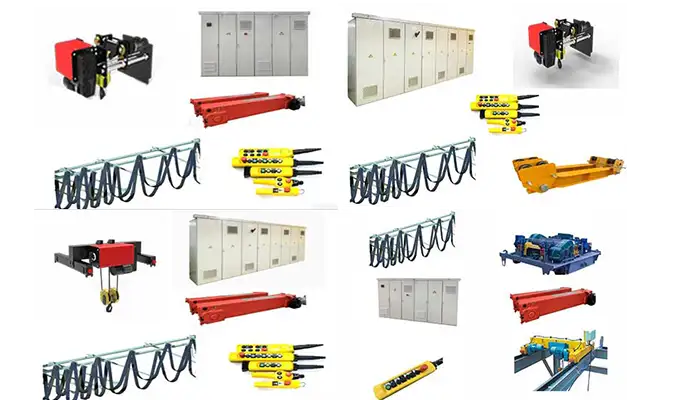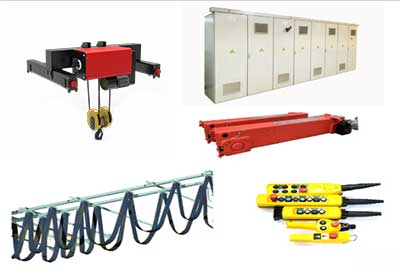
Cost-Effective Crane Kits, Overhead Crane Kit Without Girders
Here's a structured outline for the topic of economical crane kits with no girder solution, focusing on customized designs, production processes, and important considerations:
Cost-Effective Crane Kits, Overhead Crane Kit Without Girders
Crane kit for sale. The economical crane kits designed without girders, offering customizable solutions that save storage space, reduce costs, and enhance efficiency.
In recent years, the demand for economical crane kits has surged across various industries, driven by the need for cost-effective lifting solutions that do not compromise on quality or safety. These crane kits offer a practical alternative for businesses looking to optimize their operations while adhering to budget constraints. One of the most innovative aspects of these kits is the design without a main girder, which allows for versatile installations in spaces where traditional overhead systems may not fit.
The importance of customized crane kit designs cannot be overstated. Tailoring a crane kit to meet specific operational needs ensures that businesses can effectively address their unique challenges. Customized designs not only enhance efficiency but also improve safety and workflow within facilities. By considering factors such as load capacity, available space, and the nature of the tasks performed, companies can select solutions that align perfectly with their operational requirements.
This article will explore the features and benefits of economical crane kits without a girder solution, highlighting how a customized approach can lead to significant improvements in material handling and overall productivity.
What is an Economical Crane Kit with No Girder?
Definition and Explanation of the Concept
An economical crane kit with no girder is a simplified crane system designed to operate without the traditional main girder that is typically found in standard overhead cranes. Instead, these kits utilize a more streamlined design, often integrating components that allow for efficient lifting without the need for bulky supporting structures. This approach is particularly advantageous in environments where height constraints or limited space exist, making it easier to implement effective lifting solutions.
Benefits of Using a No-Girder Solution
The advantages of adopting a no-girder crane kit are significant and can have a positive impact on operational efficiency:
- Cost Savings: By eliminating the main girder, businesses can reduce material costs associated with crane construction. This also translates to lower transportation expenses, as the kit is lighter and requires less logistical support.
- Reduced Installation Time: The simpler design of no-girder solutions typically allows for quicker assembly and installation. This minimizes downtime in operations, enabling businesses to get their lifting systems up and running more rapidly.
- Space Efficiency: Without a main girder, these kits can be installed in tighter spaces, maximizing available headroom and allowing for flexible configurations. This is particularly beneficial in facilities with low ceilings or unconventional layouts.
- Customization Options: Many no-girder crane kits can be tailored to meet specific lifting requirements, such as load capacity and application type. This customization ensures that businesses have solutions that align precisely with their operational needs.
By leveraging these benefits, economical crane kits with no girder solutions provide a practical and efficient option for businesses seeking to enhance their material handling capabilities while adhering to budgetary considerations.

Single girder Suspension Crane Kit

Single Girder top running Bridge Crane Kit

Double Girder Bridge Crane Kit With Hoist

Double Girder Bridge Crane Kit With Winch
Customized Crane Kit Design
Tailored Solutions
Customizing crane kits to fit unique operational requirements is crucial for maximizing efficiency and effectiveness in material handling. Each industry and facility presents its own set of challenges, from specific load capacities to spatial constraints. A tailored crane kit ensures that the solution meets these challenges head-on, providing the following benefits:
- Optimized Performance: Custom designs can enhance lifting capabilities and operational workflow, enabling users to handle loads more efficiently.
- Increased Safety: By considering specific environmental factors and operational needs, customized crane kits can incorporate safety features that align with best practices and regulatory standards.
- Improved Integration: Customized solutions can seamlessly integrate with existing infrastructure, reducing the need for additional modifications and ensuring a more cohesive operation.
Main Girder Production Drawings
Main girder production drawings are essential documents in the manufacturing process of customized crane kits, even when no girder is involved. They serve multiple purposes:
- Detailed Specifications: These drawings provide comprehensive details about the design, dimensions, materials, and assembly instructions of the crane kit. This level of detail ensures that manufacturers have a clear understanding of what is required for production.
- Facilitation of the Production Process: With accurate production drawings, manufacturers can streamline their processes, ensuring that each component is made to the correct specifications. This minimizes errors and reduces waste, leading to a more efficient production cycle.
- Quality Assurance: Main girder production drawings play a crucial role in quality control. By outlining specific standards and tolerances, they ensure that each crane kit meets the required performance criteria before it is shipped to the customer.
By investing in customized crane kit designs and utilizing thorough production drawings, businesses can achieve lifting solutions that are not only effective but also tailored to their specific operational contexts.
Production Process of the Main Girder
Materials Used
The construction of the main girder is critical to the overall performance and safety of a crane kit. Common materials used in main girder construction include:
- Steel: The most widely used material due to its high strength-to-weight ratio, durability, and resistance to deformation. Variants like structural steel and alloy steel are popular choices.
- Aluminum: While lighter than steel, aluminum offers good corrosion resistance and is often used in applications where weight is a crucial factor.
- Composite Materials: In specialized applications, composite materials may be utilized for their lightweight properties and resistance to corrosion, though they are less common than steel and aluminum.
Manufacturing Steps
Cutting and Shaping the Materials:
- The process begins with cutting the raw materials to the specified dimensions based on the production drawings. Techniques such as plasma cutting, laser cutting, or saw cutting may be employed.
- Following cutting, the materials are shaped to achieve the necessary profiles, often involving processes like bending or machining to create the desired girder geometry.
Welding and Assembly Techniques:
- Once the components are prepared, they are assembled using welding techniques to join the pieces together. Common methods include MIG (Metal Inert Gas) welding and TIG (Tungsten Inert Gas) welding, both known for their strength and precision.
- In some cases, additional fasteners or brackets may be used to reinforce the assembly, ensuring structural integrity and enhancing load-bearing capacity.
Quality Control Measures:
- Throughout the manufacturing process, quality control measures are implemented to ensure that each main girder meets durability and safety standards. This may include inspections for dimensional accuracy, weld quality, and material properties.
- Non-destructive testing methods, such as ultrasonic testing or magnetic particle inspection, can be employed to detect any internal flaws or weaknesses in the welds.
- Final inspections are conducted before the components are shipped, ensuring that they conform to specifications and are ready for installation.
By carefully selecting materials and adhering to stringent manufacturing processes, the production of the main girder ensures that crane kits are built to last, providing reliable performance in a variety of lifting applications.
Considerations When Providing Crane Kits with No Main Girder
Load Distribution
Understanding load distribution is crucial when using crane kits designed without a main girder. Properly assessing load requirements ensures that the lifting system can manage weight effectively. Key considerations include:
- Load Types: Identify whether the loads are static or dynamic, as dynamic loads (like moving objects) can exert different forces on the structure.
- Weight Distribution: Determine how the weight of the load will be spread across the supporting framework. A well-planned load distribution can prevent excessive stress on specific points, reducing the risk of structural failure.
Structural Integrity
Assessing the structural integrity of the framework is essential to ensure that it can support the intended loads. This involves:
- Material Strength: Evaluating the materials used in the crane kit to confirm they meet or exceed strength requirements for the anticipated loads.
- Design Analysis: Conducting a structural analysis to verify that the framework can withstand operational forces, including bending moments and shear forces, even without a main girder.
Installation Procedures
Best practices for installing a crane kit without a main girder include:
- Site Assessment: Conduct a thorough site assessment to determine the best installation location, considering factors like headroom, clearance, and existing infrastructure.
- Preparation: Ensure that all components are available and that the installation area is clear. A detailed installation plan can help streamline the process.
- Alignment and Leveling: During installation, ensure that the crane kit is properly aligned and leveled to facilitate smooth operation and prevent wear or damage.
Safety Regulations
Compliance with industry safety standards and guidelines is paramount when providing crane kits without a main girder. Key aspects include:
- Regulatory Compliance: Familiarize yourself with local and national safety regulations governing crane installations. This may include standards set by organizations such as OSHA (Occupational Safety and Health Administration) or ANSI (American National Standards Institute).
- Safety Features: Ensure that the crane kit incorporates essential safety features, such as overload protection, emergency stop buttons, and proper signage to inform operators of safe practices.
- Training: Provide comprehensive training for operators and maintenance personnel to ensure they understand the specific safety requirements associated with the crane kit and its operation.
By carefully considering these factors, businesses can successfully implement crane kits with no main girder while ensuring safety, efficiency, and structural integrity.
Advantages of No-Girder Crane Kits
Space Efficiency
No-girder crane kits are designed to optimize workspace utilization, making them particularly valuable in environments where height is limited. By eliminating the need for a main girder, these kits can:
- Maximize Headroom: With components mounted directly to existing structures, businesses can use vertical space more effectively, allowing for higher stacking of materials and improved workflow.
- Enhance Accessibility: The absence of a main girder allows for unobstructed movement beneath the crane, facilitating easier access to areas that require frequent handling of materials or equipment.
Cost-Effectiveness
These crane kits provide significant savings in both materials and installation:
- Reduced Material Costs: Without the need for a main girder, the overall material requirements are lowered, which can lead to cost reductions in purchasing and manufacturing.
- Simplified Installation: The installation process for no-girder crane kits is often faster and less complex, reducing labor costs and downtime. This allows businesses to get their lifting solutions operational more quickly, translating to better productivity.
Flexibility
No-girder crane kits offer remarkable adaptability to various operational needs:
- Custom Configurations: These kits can be tailored to specific lifting tasks, accommodating different load capacities and operational requirements without the constraints of a traditional main girder design.
- Ease of Relocation: Their lightweight design and modular nature make these crane kits easier to relocate or reconfigure, providing businesses with the agility to adapt to changing operational demands.
Conclusion
In summary, economical crane kits with no-girder solutions present a range of benefits, including enhanced space efficiency, cost-effectiveness, and adaptability to various operational needs. By understanding the advantages and considerations associated with these kits, businesses can make informed decisions that optimize their material handling processes.
Exploring customized options allows companies to tailor their crane solutions to meet specific challenges, ultimately enhancing operational efficiency and productivity. Investing in the right crane kit can lead to significant long-term benefits, making it a valuable consideration for any industrial application.



